It's Human Nature
Maria Kronfeldner Lunchtime Talk
"The Genealogical Concept of Human Nature"
February 12, 2013
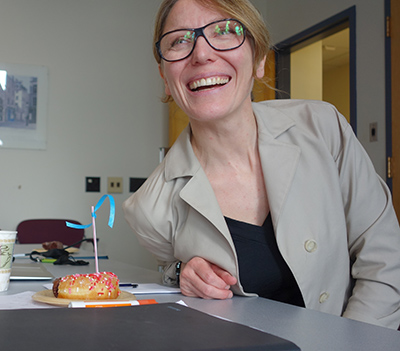
At the Center, we are well into the academic year. Our Fellows have read each other's papers multiple times and have exchanged thoughts, reactions, advice and confidences. We have become a comfortable community of friends. In the process, every Fellow has given a lunchtime talk.
The first time a Fellow stands to give a talk, it is little frightening. The Fellow speaks to Center visitors who are still mostly unknown to them, as well as local faculty and graduate students. Now the unknowns are gone. Giving a talk has become an opportunity to try out ideas on friends and get some helpful discussion. We are getting requests to give second talks. Such a talk is on our agenda for today. Maria will speak.
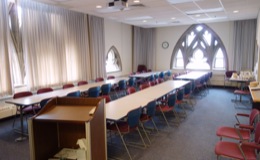 The talk is at noon. A little after 11, I see Maria speeding into the seminar room with evident purpose. I follow. She's likely setting up her computer and I want to be sure that there are no glitches. But she hasn't taken her computer with her. She's looking at the room. The talk is at noon. A little after 11, I see Maria speeding into the seminar room with evident purpose. I follow. She's likely setting up her computer and I want to be sure that there are no glitches. But she hasn't taken her computer with her. She's looking at the room.
She turns to me and asks:
"Is it possible for me to sit in a chair and talk?"
"Yes, of course," I say. However I feel that I need to say more.
"You know I think a talk works much better if the speaker stands. It's more dynamic. You project better. There's more body movement and body language."
Maria was not convinced.
"Yes, but I think it is friendlier if I sit."
The conversation went to and fro like this for a while. Of course Maria has the final say. It's her talk and that is what I told her. She will be seated. That is the decision.
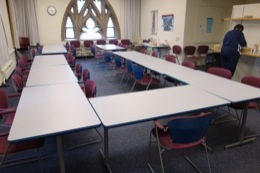 "I think if we are all sitting together the discussion will be friendlier." "I think if we are all sitting together the discussion will be friendlier."
By this time, we had assembled Joyce and Eric. It was not just a matter of dropping a chair at the front of the room. With the present arrangement, that would be odd. "Can we rearrange the tables in the way the Provost uses them for meetings?" Then the tables are in a U shape. Maria can sit at the table at the front.
The next time I looked in on the room, Eric had dragged a table from the back and it was set up at the front. It had happened so fast that I didn't see him do it.
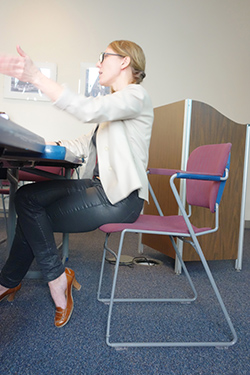
Soon Maria was seated at the front of the room, on the edge of her chair, and the talk had begun. The topic is human nature and how our understanding of it is to be fitted with our knowledge of biology. Just what distinguishes us as human? It is a topic that had escaped my scrutiny, so my modest goal was merely to move my understanding beyond the novice level.
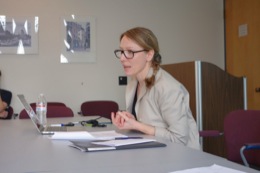 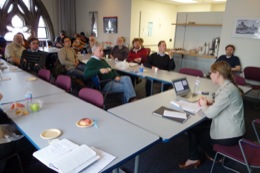
It began as expected. As with any philosophical problem, there are no easy answers. Once we may have sought necessary and sufficient conditions for human nature. If you have A, B, C, ..., then you are human and you cannot be human without them.
That didn't work, the literature had figured out long ago. Maria now stood and went to the whiteboard to draw a Venn diagram of the various conditions, pointing to the individuals that were missed by various unfortunate combinations of conditions.
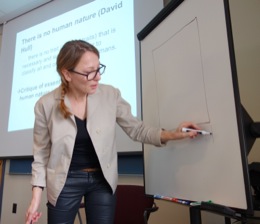 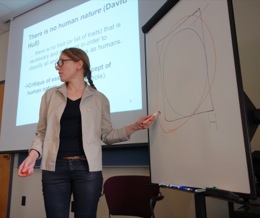
This much seemed plausible. I was following. But this proved to be the simplest of the ideas of talk. The complications and terms of art kept coming. There were nomological, epistemological, genealogical and evolutionary perspectives and rapid turns to and fro amongst fine gradations within them. There are many details here. Maria cherishes them and is eager to share them all with us.
 A familiar character appeared: "Osama sim Laden", who is otherwise known as a version of swampman. He a the perfectly constructed android with all the traits we deem typical of a human. But he was constructed on Mars. He has no hereditary connection to our human species. So he cannot be human. Or so we were assured. I should have been paying more attention to the basis of that assurance since I'm still not sure why he cannot be human. However I was distracted by swampman. From Mars? Or from a marsh? He is swampman... A familiar character appeared: "Osama sim Laden", who is otherwise known as a version of swampman. He a the perfectly constructed android with all the traits we deem typical of a human. But he was constructed on Mars. He has no hereditary connection to our human species. So he cannot be human. Or so we were assured. I should have been paying more attention to the basis of that assurance since I'm still not sure why he cannot be human. However I was distracted by swampman. From Mars? Or from a marsh? He is swampman...
The man returned in question time. I took my opportunity and called out "Is that Mars or marsh?" To my consternation, everyone laughed. It seemed they all already knew. Maria affirmed that it was Mars. She wanted to be sure that there was no possibility of a hereditary connection to our species. The dearth of ready interplanetary transportation would take care of that.
Maria proceeded. She pruned and molded the details until her principal claim emerged. Human nature resides in causal factors that are typical of us and that we have because of our biological-genealogical relation to our ancestors. The causal factors are--here I wrote down the words to be sure I had them--"clusters of genes and other hereditary factors."
Maria had been concerned that the talk be friendly. Given the cosiness that had developed over the year, the worry had seemed superfluous.
"We are not afraid of you," I had quipped. As the talk unfolded, however, I could see that things were not so straightforward.
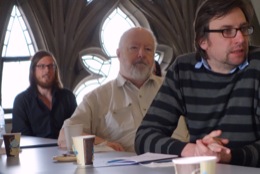 In developing her account, Maria made repeated references to two other accounts. It was not clear at first whether she was disputing them. As the talk developed, my sense grew that she was. They were accounts by Edouard Machery and Paul Griffiths. And Ken Schaffner was also mentioned from time to time. In developing her account, Maria made repeated references to two other accounts. It was not clear at first whether she was disputing them. As the talk developed, my sense grew that she was. They were accounts by Edouard Machery and Paul Griffiths. And Ken Schaffner was also mentioned from time to time.
Both Edouard and Ken were in the room; they are permanent HPS faculty in Pittsburgh. However Paul Griffiths was also present and sitting at the front. He happened to be passing through at the right moment. That made sense of Maria's concern to cover every detail and complication. She was not just speaking to her friends in the Center. Her audience included the formidable experts sitting just feet away.
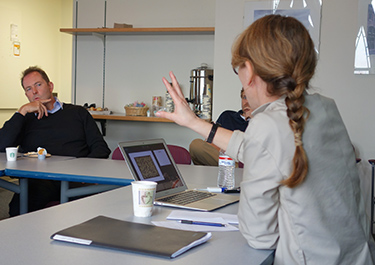
The talk closed. We took a short break to deal with the remaining bagels and donuts. Question time opened. My habit is to jot down who wants to ask questions and then go through the list. I was immediately overwhelmed by a forest of hands. It threw me. "Is there anyone who doesn't want to ask a question?" I asked, as I recovered my equilibrium.
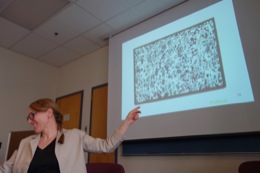 What had puzzled me in the talk was Maria's notion of "clusters of genes and other hereditary factors." It seemed open to me. Or was it a term of art in biology with a quite precise meaning?
What had puzzled me in the talk was Maria's notion of "clusters of genes and other hereditary factors." It seemed open to me. Or was it a term of art in biology with a quite precise meaning?
This same concern attracted much attention. Edouard pressed it hard. Just how do we use it to distinguish the factors that Maria intends from those that she does not? Gravity? Water? Oxygen? Paul Griffiths also pressed the point, although he couched it as a gentle request for clarification. What about antibodies in mother's milk?
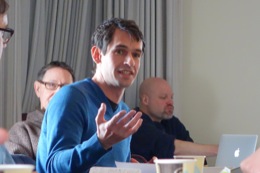 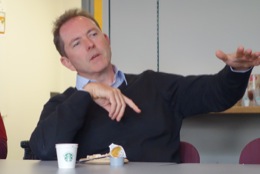
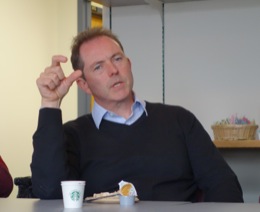 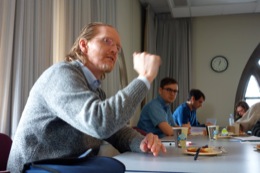
The discussion proceeded in this vein. It was energetic and probing. The exchanges were too rich and focussed to say that they were cosy. That suggests an idleness and leisure I did not see. But they were friendly.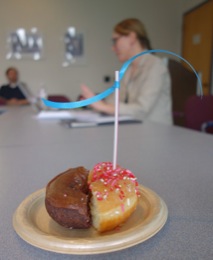
When time was up, I could not proceed to the traditional closing ceremony of the bestowing of the umbrella. Her umbrella had been bestowed upon her last term and, as I explained, it could not be done again. However, as a consolation, I offered her a fine selection of the best donut parts. The offering had been laid on the table in preparation since the start of the talk.
After the event, people lingered to talk. And they lingered. Two hours later, Maria was still in energetic discussion with Edouard and Paul.
When it was over, I found Maria chatting with Alex in the hallway. I asked after the plan of sitting and speaking. "Did it work?" Yes," she said without the slightest hesitation, "I was much more relaxed."
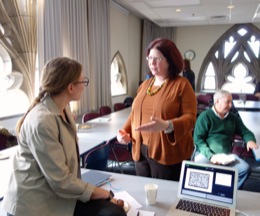
John D. Norton
|